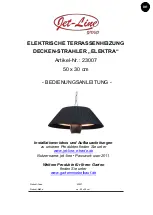
01.02.2018
CORTEK
Page 13 / 24
EN
3. INSTALLING THE EQUIPMENT
•
Place the tank and its safety unit (and/or safety valve)
in a frost-free place.
• Position it as near as possible to the most-used taps.
• If it is placed outside occupied areas, insulate the pipework. If the device needs
to be installed in a location where the ambient temperature is always above 35°C,
ensure the space is ventilated.
• Ensure that the supporting structure is strong enough to take the weight of the tank
when it is filled with water.
•
Allow a minimum of 1 metre in front of the flange for regular maintenance of the tank
and for inspecting the magnesium anode.
•
Fit a retention tank with a drain beneath the tank if it is located in a loft or above premises
in use.
•
The safety unit and/or safety valve must be accessible.
•
A drain connection must be provided equipped with a funnel.
•
The lower tapping allows the tank to be drained fully.
•
The tank only operates in the vertical position.
4. HYDRAULIC CONNECTION
Before proceeding with the hydraulic connection, the supply pipes must be thoroughly
cleaned to avoid introducing metal or other particles into the tank.
If metal pipes are used, the connection to the hot water outlet must use a dielectric pipe
joint or cast-iron sleeve to prevent galvanic corrosion (iron-copper). Brass connections
are prohibited here. A certified safety unit or non-return flap and safety valve assembly is
obligatory.
If the network supply pressure is ≥ 0,5 MPa (5 bar), a pressure reducer must be fitted to the
distribution outlet. A pressure of 0,3 to 0,4 MPa (3 to 4 bar) is recommended. Check that the
pressure does not exceed the service pressure in operation.
Fit a bleed outlet to the tank´s top connection (DHW outlet).
To avoid clogging the installation´s components (heat exchangers, safety valve, safety unit)
with sludge, a filter must be fitted to the domestic cold water supply outlet feeding the tank.
The domestic hot water in the tank can reach a high temperature. It is thus essential to fit a
thermostatic mixing valve before water is distributed to the taps. The temperature setting at
the taps should comply with the regulations in force.
Recommendations:
In very hard-water regions (Th>20°F), the use of a softener will not
invalidate the warranty as long as the softener is set up in accordance with standard practice
and is checked and maintained regularly.
The water hardness must remain above 10°f.
4.1. Hydraulic safety
All installations must include hydraulic protection against:
1.
Excess pressure in the distribution network,
2.
Excess pressure due to rises in temperature (expansion during heating),
3.
Excess pressure due to the failure of a thermostat or a contactor relay.
If COMPOSITE MATERIAL pipes (PER, PVC etc.) are used a temperature limiter must
be fitted to the tank output and adjusted according to the performance of the material
used.










































